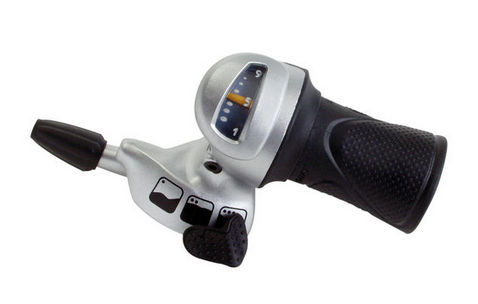|
Translations of this article:
|

|

![]()
![]()
![]()
![]()
The SRAM DualDrive hybrid-gearing system had a three-speed internal-gear hub and a splined cassette body to mount a Shimano-Hyperglide-compatible 8-, 9- or 10-speed cassette. The system included the hub and cassette, a rear derailer, clickbox, cable and a combined dual-shifter assembly for flat handlebars. The hub was shifted by a thumb-lever mechanism, and the derailer, by a twist grip. Cassettes could have 8, 9 or 10 sprockets. The cassette assembly was compatible with most Shimano derailers, but the SRAM derailer used SRAM's longer cable pull. The hub could be shifted by the combined SRAM shifter or by the one for the SRAM i-Motion 3 hub -- an unintended compatibility. When using the combined shifter, derailer choices are limited to those of the SRAM 3.0 system.
The DualDrive hub is no longer in production, though as of 2022, replacement parts may be found with an eBay search, and some shops still have them. Bike Friday sold many bicycles with DualDrive hubs.
The image below shows a shifter assembly for a DualDrive system with a 9-speed cassette. The shifter assembly for an 8- or 10-speed cassette is different, due to the different number and spacing of sprockets. Installation of cables in the shifter requires disassembly -- see directions linked at the end of this page.

![]()
![]()
The image below shows a DualDrive clickbox from the underside with the cover (at the left) removed -- it pops off. You must remove and replace the cable in the clickbox to shorten it or install a new one. At the right side of the image are the end of the cable housing, and a cable adjuster. The inner cable threads through from front to rear (right to left in the image). The red arrow points to the anchor bolt which clamps down the end of the cable. There isn't room to install the usual aluminum cap -- you can see the strands of the cable end peeking out. The anchor bolt is at one end of a small bellcrank inside the clickbox, and a tab is at the other end.
A pullrod with a head that has a screwdriver slot shifts the hub. The green arrow points to the tab which pulls the head of the pullrod outward. The blue arrow points to where the end of the pullrod enters the clickbox.
The next image shows the assembled clickbox with the cover and pullrod in place. The tab is underneath the head of the pullrod, and pulls it out when the cable is tightened. The innermost (released) position of the pullrod is for the hub's top gear.
![]()
![]()
The next picture shows the clickbox from the top, installed on the right and of the axle. The red arrow points to a button. Press the button to free the clickbox when when installing or removing it. The green arrow points to yellow markings on the top of the clickbox. When the hub is in its middle gear, the tab inside the clickbox should fall between the markings.
The clickbox is a fragile plastic part in a vulnerable location. It should always be installed along with the supplied guard, in case the bicycle falls onto its right side.
The pullrod might be modified into an indicator spindle and chain, but this would some custom work and I am not sure what the resulting cable pull would be. Because the older Sachs/SRAM 3 x 7 hub does use an indicator spindle and chain, I like it better than the DualDrive. Same with Sturmey-Archer hybrid gearing hubs. But you work with what you have!
![]()
![]()
Last Updated: by Author